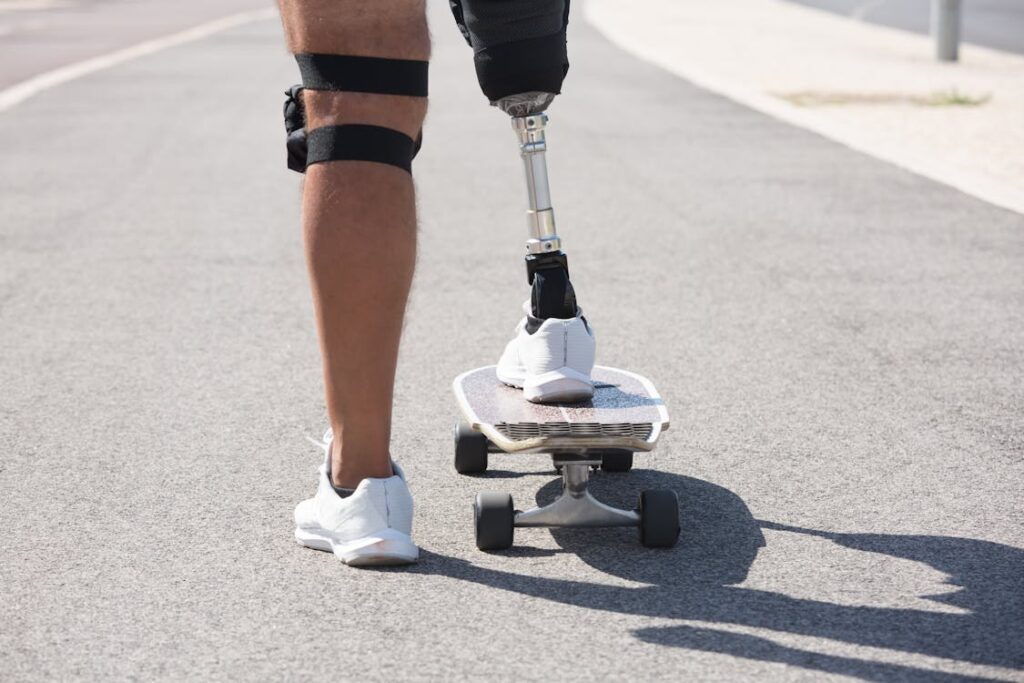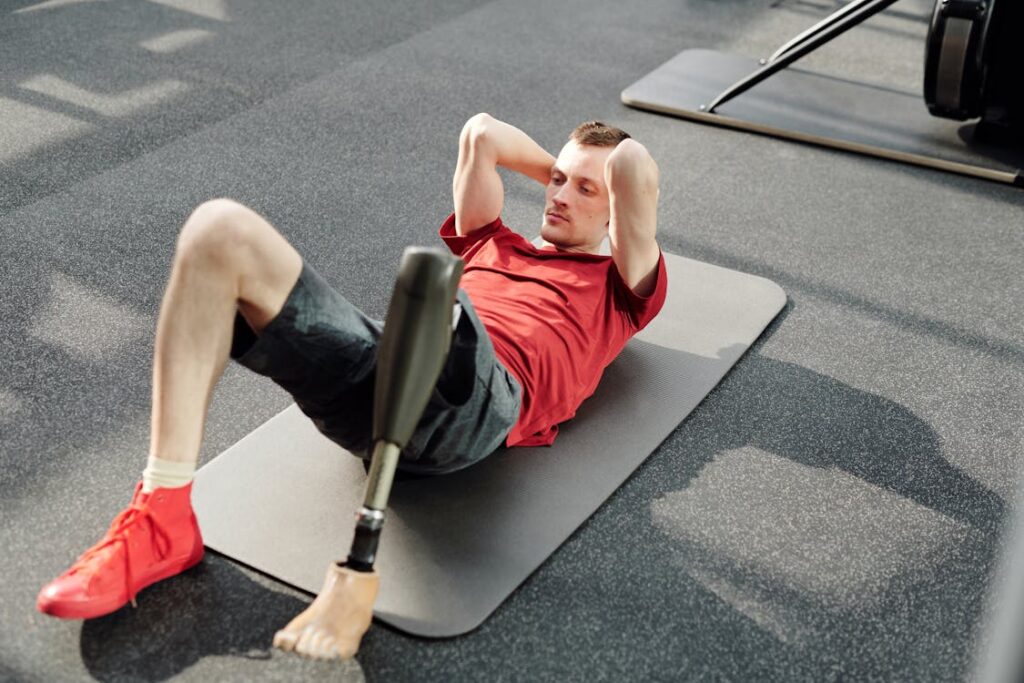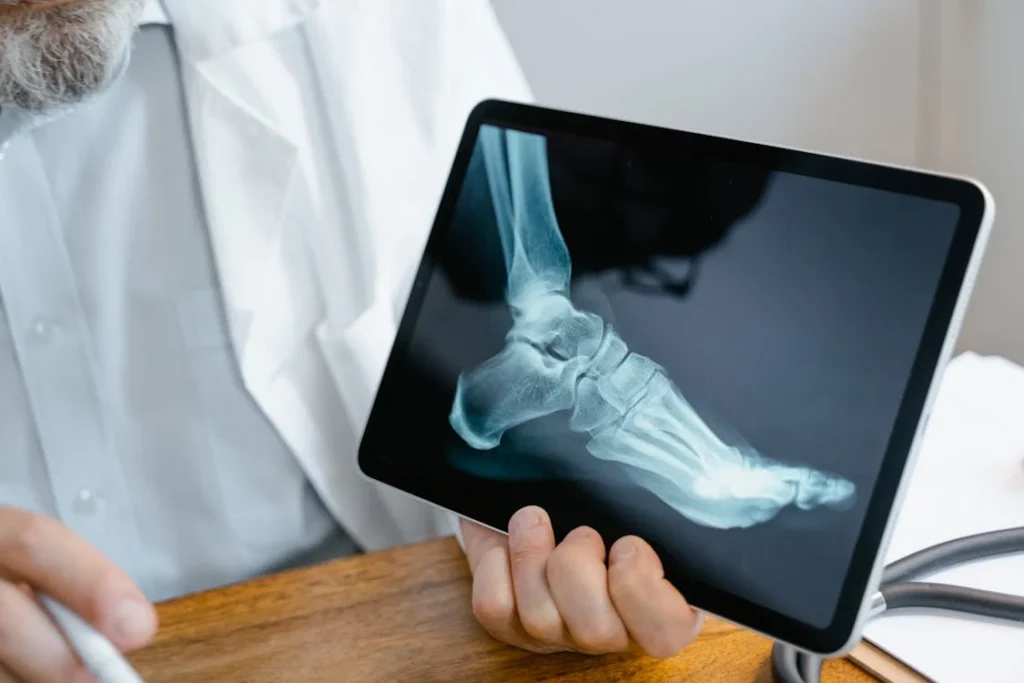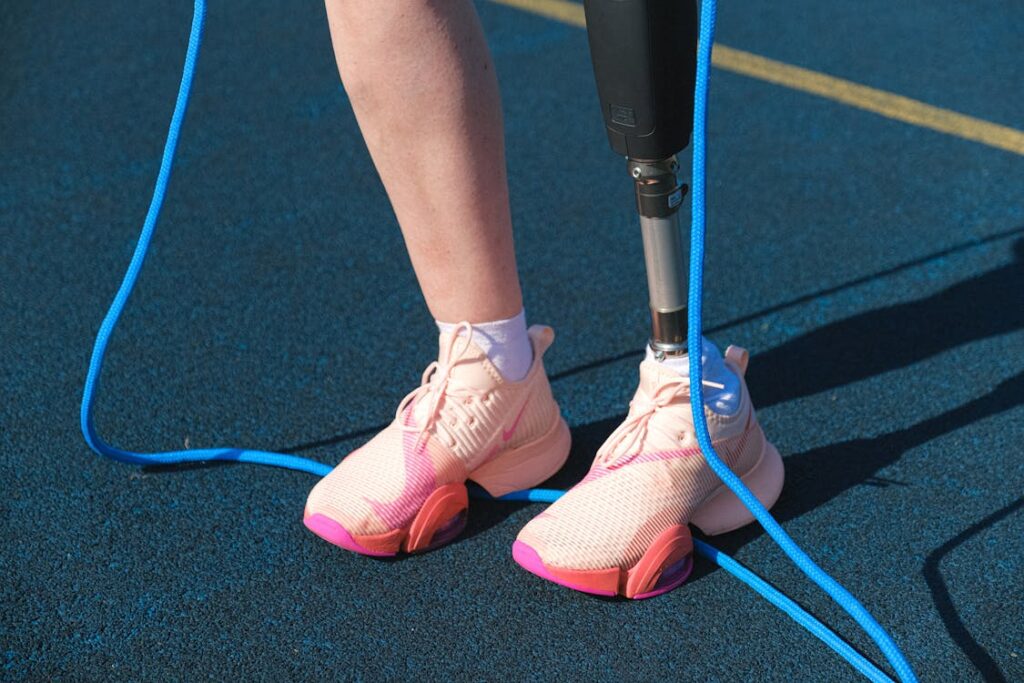Every step you take sends a message through your body. For people with a prosthetic leg, that message comes through the foot — the very part designed to carry weight, manage shock, and keep balance with every move.
Prosthetic feet have come a long way. What once was a rigid block has now evolved into a smart, flexible, and adaptive tool. But not all feet are created equal. The design, materials, and mechanics of a prosthetic foot play a major role in how well it can carry the body’s weight and absorb the impact of walking, running, or standing.

Understanding Load and Shock in Human Movement
What Happens During a Step
When you take a step, your foot hits the ground and your whole body reacts. At that moment, your body weight shifts forward and downward, pressing into the foot.
This is called load. Then comes the shock — a quick burst of pressure that travels up from the ground through your foot, leg, and into your spine.
In a natural foot, bones, muscles, and soft tissue work together to absorb this shock. They spread it out and slow it down so that the rest of the body isn’t shaken or hurt.
The arch of the foot compresses, the ankle bends, and the heel softens the first impact. All of these small movements protect your joints and help your steps feel smooth.
When a person has a prosthetic foot, the job of absorbing that shock and managing that load must be handled by the artificial foot. It doesn’t have muscle or bone — only design, structure, and materials.
That’s why the technology inside a prosthetic foot matters so much. A good foot reduces pain and fatigue. A poorly matched foot can make every step harder and more draining.
Why Load and Shock Are Bigger Issues for Amputees
For someone using a prosthetic leg, every bit of force from the ground matters more. The missing biological parts — bones, tendons, soft tissues — are no longer there to share the work.
The socket that holds the residual limb becomes the main point where force is received. If the prosthetic foot doesn’t handle load and shock well, the pressure travels up into that socket and into the limb.
That causes discomfort, skin breakdown, and long-term fatigue.
It’s not just about comfort, either. Poor shock absorption affects balance and gait. A person may lean forward or shift weight to avoid pressure. Over time, this can lead to back pain, hip pain, and joint stress.
That’s why choosing the right foot, and understanding how it handles these forces, is one of the most important decisions after amputation.
Some people may not notice the shock immediately — it builds slowly. But by the end of the day, their body feels it.
Muscles are sore. The limb feels tired. That’s the hidden cost of poor load handling. A foot that looks fine may still be overloading the body with stress it doesn’t need.
The Role of Energy in Load Management
There’s another side to this story — energy. When you walk, your body stores and releases energy. A natural foot bends and springs back with each step, helping to push you forward. This reduces the work your muscles have to do.
Modern prosthetic feet are designed to mimic this function. Some feet are made with carbon fiber or other spring-like materials that bend when loaded and snap back when released.
This gives the user a gentle boost with each step. It’s not just more comfortable — it helps save energy.
A well-designed foot spreads the load, softens the shock, and returns energy efficiently. That makes walking less tiring, especially over long distances.
Without this, walking becomes hard work. Each step feels like starting from scratch, with no help from the limb itself.
This is why prosthetic feet are more than just support. They are tools of movement — engineered to make motion possible, smoother, and less draining. The right foot doesn’t just hold your weight. It helps carry you forward.

Types of Prosthetic Feet and Their Impact on Load and Shock
Basic Feet: Solid but Limited
The most basic kind of prosthetic foot is called a SACH foot — short for Solid Ankle Cushion Heel. It doesn’t move much. It has no real ankle motion and uses a thick heel to absorb shock.
While it’s reliable and simple to maintain, it offers very little energy return. It’s mostly used for people with lower activity levels who walk on flat surfaces and don’t need much flexibility.
The downside is that SACH feet don’t adapt well to uneven ground. They can feel stiff and may cause more shock to travel up the leg.
That means the residual limb and socket take more stress during walking. These feet are cost-effective and lightweight, but not always ideal when shock absorption is a high priority.
Flexible Keel Feet: A Smoother Ride
To solve the stiffness of solid feet, flexible keel designs were created. These allow the foot to bend more during movement, which spreads out the pressure better.
When a user steps down, the foot flexes slightly at the mid-foot, allowing for a smoother transfer of weight.
This flexibility absorbs more shock than a SACH foot, reducing stress on the knee and hip. It also helps with walking over small obstacles or slopes.
Although it still doesn’t return much energy, it creates a more natural walking feel, which matters a lot for comfort and daily use.
Dynamic Response Feet: Engineered for Motion
Dynamic response feet use advanced materials like carbon fiber to store and release energy. These are often called energy-storing or spring feet.
When the user steps down, the foot compresses slightly, and then rebounds — pushing the user forward with every step. This mimics the spring of a natural foot and improves walking speed and comfort.
These feet are a big improvement when it comes to handling both load and shock. They flex to absorb impact, then snap back into place to help move the body forward. This dual action reduces the amount of energy the body must spend on walking.
Because they handle both shock and motion, dynamic feet are often preferred for people who walk a lot, move over uneven ground, or live active lifestyles.
They help spread load more evenly across the prosthetic system, protecting the residual limb from excess stress.
Multi-Axial Feet: Moving with the Terrain
Some feet go beyond simple up-and-down motion. Multi-axial feet allow movement in several directions — forward, backward, side-to-side, and rotational. These feet are useful for people who often walk on slopes, hills, or rough surfaces.
This kind of motion lets the foot adjust to the ground, which keeps the user more stable and reduces the shock of sudden movements.
Instead of the whole leg feeling a sharp jolt from an uneven surface, the foot takes the hit and adjusts. This lowers the risk of falls and reduces joint pain over time.
Multi-axial feet are especially helpful for above-knee amputees, who already deal with more force traveling through their limbs. By giving the foot more freedom to move, these designs ease the burden on the rest of the prosthetic system.

Material Matters: How Design Choices Affect Performance
Why Material Choice Changes Everything
When it comes to prosthetic feet, the materials used aren’t just about durability — they decide how the foot will respond to weight, pressure, and motion.
The wrong material can make a foot feel too stiff or too soft. The right one can help absorb shock, spread load evenly, and return energy with each step.
Older prosthetic feet were often made from wood, plastic, or rubber. These materials were strong but had limited flexibility. They could handle weight but didn’t give much back in terms of comfort or energy return.
Today, most modern feet use advanced composites, like carbon fiber, because of their strength-to-weight ratio and dynamic properties.
Carbon fiber is light, tough, and naturally springy. When compressed under the user’s weight, it bends slightly and then pushes back.
This is the action that provides energy return — a key factor in reducing the effort it takes to walk. It also helps smooth out the impact of each step, lessening the jarring forces that travel up the leg.
How Soft Components Improve Shock Absorption
Some prosthetic feet include heel cushions, toe pads, or internal bumpers made from softer materials like silicone or polyurethane.
These are placed in specific areas to absorb shock — especially during heel strike, which is when the foot first hits the ground.
These components don’t return energy like carbon fiber, but they do make a big difference in comfort.
They take the edge off hard landings and protect the residual limb from sudden jolts. For many users, this can be the difference between walking with confidence and walking with pain.
Softer materials also help reduce skin issues inside the socket. When the prosthetic foot does a better job absorbing shock, less pressure builds up in the limb. That means fewer pressure sores, less rubbing, and less discomfort at the end of the day.
Matching the Material to the User’s Needs
There’s no perfect foot for everyone. The material needs to match the person’s lifestyle, limb condition, and daily challenges. Someone who spends most of the day standing or walking slowly might benefit from a foot with a soft heel for comfort.
Someone who walks long distances or climbs stairs often may need a carbon fiber foot that gives more energy return.
It’s not just about activity level, either. A person’s weight, balance ability, and walking style all affect what materials will work best.
That’s why fitting a prosthetic foot is not just about measurements — it’s about understanding how a person moves and what kind of support they need from the ground up.
Sometimes, the best setup involves a mix of materials. A foot might have a carbon fiber keel for strength and a soft heel insert for comfort.
Or it might combine a flexible midfoot with a rigid forefoot to create both shock absorption and forward push. These blended designs give more precise control over how load and shock are handled, creating a smoother, safer walking experience.

Adapting to Daily Life: How Environment Shapes Load and Shock Needs
Walking on Different Surfaces
The ground we walk on is never the same. Some days it’s smooth pavement. Other times it’s a gravel path, a grassy field, or a flight of stairs. For someone using a prosthetic foot, each of these surfaces affects how load and shock are felt.
Flat surfaces are the easiest for a prosthetic foot to handle. The weight is evenly distributed, and the foot can move through its full range without too much surprise.
But the moment the ground tilts, dips, or feels uneven, things get more complicated. The shock becomes unpredictable, and the foot needs to adjust quickly.
If a prosthetic foot is too rigid, it can’t adapt. The user will feel more of the impact in their residual limb, and they’ll have to work harder to stay balanced.
A foot with multi-axial movement or flexible components can shift slightly as the ground changes beneath it. That movement absorbs some of the unexpected force and protects the body from strain.
Everyday tasks — walking on ramps, stepping into a vehicle, climbing a curb — become much easier when the prosthetic foot is responsive. It’s not just about walking from point A to point B. It’s about feeling confident on the journey there.
Weather and Seasonal Challenges
Even the weather changes how load and shock are experienced. Wet surfaces, mud, snow, or loose sand can reduce traction.
This makes the body tense up to stay upright, which adds extra pressure to the socket and residual limb.
A prosthetic foot that has a grippy sole or a more adaptive shape can reduce the slipping sensation. That means fewer sudden jolts, fewer recovery steps, and less overall energy spent just trying to stay on your feet.
For people living in areas with lots of seasonal changes, having a foot that adjusts well is key. A stiff foot might be fine on dry tile, but feel unsafe on a wet street.
A design that handles shock well helps reduce those sudden bursts of pressure when you slip slightly or misstep on uneven ground.
In colder weather, shock can also feel harsher. Muscles stiffen, and the limb may feel more sensitive. This is where soft heel inserts or well-padded liners come in. They soften the blow and keep the limb protected even when the environment makes things harder.
Indoor vs Outdoor Use
Inside the home, movement is slower and more controlled. But this also means a lot of stopping, turning, and standing in one place.
These small, repeated movements can create pressure in ways we don’t always expect. Standing still, for example, doesn’t give the prosthetic foot much opportunity to absorb load. That pressure builds directly under the socket.
A good prosthetic foot for indoor use should provide a stable base. It should handle slow shifts in weight without feeling wobbly.
It should also allow for easy, safe turning, which reduces torsion forces on the limb.
Outdoors, the challenge is more about variability. The foot must handle all kinds of forces — starting, stopping, stepping up or down — while still reducing shock and protecting the user.
Some advanced feet include rotational components that help turn the foot naturally while walking, reducing the twist that travels up the limb.
Being able to move between indoor and outdoor settings without changing how you walk is a sign that your prosthetic foot is doing its job. It’s adapting for you, so you don’t have to constantly adjust your balance or pace.

Clinical Assessment and Customization: Getting the Fit Just Right
Why a Professional Evaluation Matters
Choosing a prosthetic foot isn’t about picking the most advanced or most popular model. It’s about finding the foot that works best for you.
That’s why clinical evaluation is such a critical step. A trained prosthetist doesn’t just look at your measurements. They watch how you move, how you stand, and how your body reacts to different surfaces and tasks.
The process often starts with a gait analysis. This is where the clinician studies how you walk — from how your heel strikes the ground, to how your body weight shifts, and how your toes lift off.
These small details tell a story. They show where load is being handled well and where shock might be causing problems.
The assessment also includes a review of your lifestyle. How much do you walk? Do you work? Do you spend more time indoors or outside?
These questions help shape the decision, because different feet are better suited for different patterns of movement and activity levels.
By paying attention to these fine details, clinicians can recommend a foot that doesn’t just support your weight, but also improves your comfort, energy, and stability.
This is how prosthetics become personal — not one-size-fits-all, but one-fit-for-you.
Trial Fittings and Adjustments
Even with a solid evaluation, the first foot might not feel perfect right away. That’s normal. Real life is always a little different than a clinical room.
Once the user starts moving around at home or work, they may notice things they didn’t feel during the first fitting — a bit of discomfort, uneven pressure, or extra shock in certain areas.
That’s why trial periods and follow-up adjustments are so important. Small changes in foot height, alignment, or component stiffness can make a huge difference in how the foot handles load and shock.
A slight tilt in angle might reduce impact during heel strike. A change in foot stiffness might make stairs feel more natural.
The goal is to fine-tune everything so that each step feels predictable and smooth. The better the fit, the less the user has to think about their movement — and the more energy they save throughout the day.
At Robobionics, we believe in continuous care. Fitment isn’t a one-time event. It’s a partnership. The more honest feedback users give, the more precisely we can adjust the technology to work in their favor. And that’s where lasting comfort really begins.
Limb Volume and Socket Fit: A Changing Relationship
There’s one more piece to the puzzle: the residual limb itself. It changes — not just over time, but even during the day.
Heat, activity, or time spent standing can cause the limb to swell slightly. These shifts affect how the socket fits, which changes how weight and shock are handled.
A tight socket might increase pressure and trap shock. A loose socket might allow too much movement, leading to friction and instability.
Either way, it makes the prosthetic foot work harder to maintain balance and comfort.
Good prosthetic care includes checking in on socket fit regularly. Sometimes this means changing the liner. Sometimes it’s adjusting the padding. In some cases, the socket may need to be reshaped or replaced to match the current shape of the limb.
None of these changes mean something is wrong. In fact, they show the system is working as it should — growing and adapting with the user.
When socket fit and foot performance are in sync, load is handled smoothly, and shock is absorbed effectively. That’s when walking feels natural again.

The Future of Prosthetic Foot Technology
Smart Systems and Responsive Designs
Technology in prosthetics is moving fast. We’re no longer limited to passive systems that simply support weight. Today, many prosthetic feet are becoming smart — using sensors and microprocessors to adjust how they respond to each step in real time.
These intelligent feet can detect walking speed, changes in terrain, or sudden movements.
Based on that data, they adapt their stiffness or position to give more or less support. For example, walking up stairs might trigger the foot to stiffen and provide extra push. On flat ground, it might soften to reduce shock.
This level of responsiveness helps manage both load and shock more effectively than traditional feet.
It also reduces the mental strain on users, who no longer need to constantly adjust their movement or posture. Instead, the foot works with them — reacting and adapting, just like a biological foot would.
At Robobionics, we’ve seen how these advances are changing lives. They give users more freedom, more energy, and more confidence to take on their day.
Making Innovation More Accessible
As promising as these smart technologies are, cost and availability can be a barrier.
Many of the most advanced systems are still priced beyond reach for many people — especially in countries where insurance coverage is limited or healthcare support is uneven.
That’s why we believe innovation should never come at the cost of accessibility. There’s a strong push in the industry — and especially in India — to make high-quality prosthetics that are also affordable.
The future isn’t just about more advanced designs, but smarter designs that give more people access to better mobility.
New materials, better manufacturing techniques like 3D printing, and localized support networks are helping make this possible.
These developments not only lower costs but also allow for more custom solutions based on each user’s body and environment.
Moving Toward a More Natural Experience
Ultimately, the goal of prosthetic foot technology isn’t just to support weight or reduce shock. It’s to restore the feeling of natural movement. Every improvement — in materials, design, or function — brings us closer to that goal.
When walking feels smooth and balanced, when the user doesn’t have to overthink each step, when the limb no longer aches at the end of the day — that’s when technology is truly doing its job.
Prosthetic feet may not yet match everything a human foot can do, but they’re getting closer every year. And for the people who rely on them every day, these improvements are more than technical — they’re personal. They mean freedom, comfort, and dignity.
Conclusion
The foot is the first part of the body to touch the ground — and for someone using a prosthetic, it carries even more responsibility. It must manage weight, absorb shock, adapt to the ground, and support every movement, big or small.
Understanding how prosthetic foot technology works — especially in terms of load and shock absorption — helps users make better choices. It helps caregivers provide better support. And it helps clinicians offer more effective care.
With the right foot, steps become easier. Fatigue is reduced. Confidence grows. And life opens up again — one comfortable, supported, energy-efficient step at a time.



